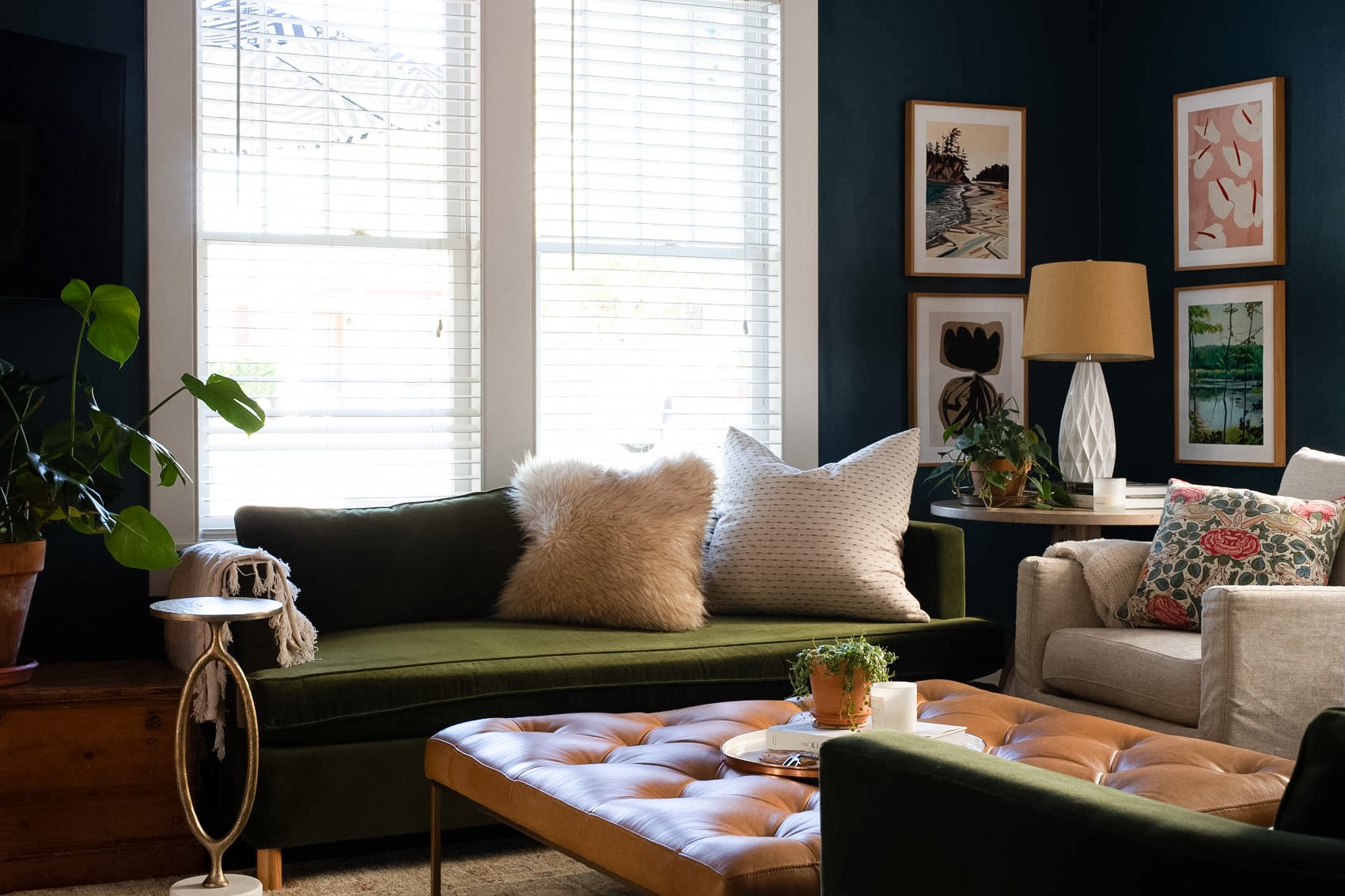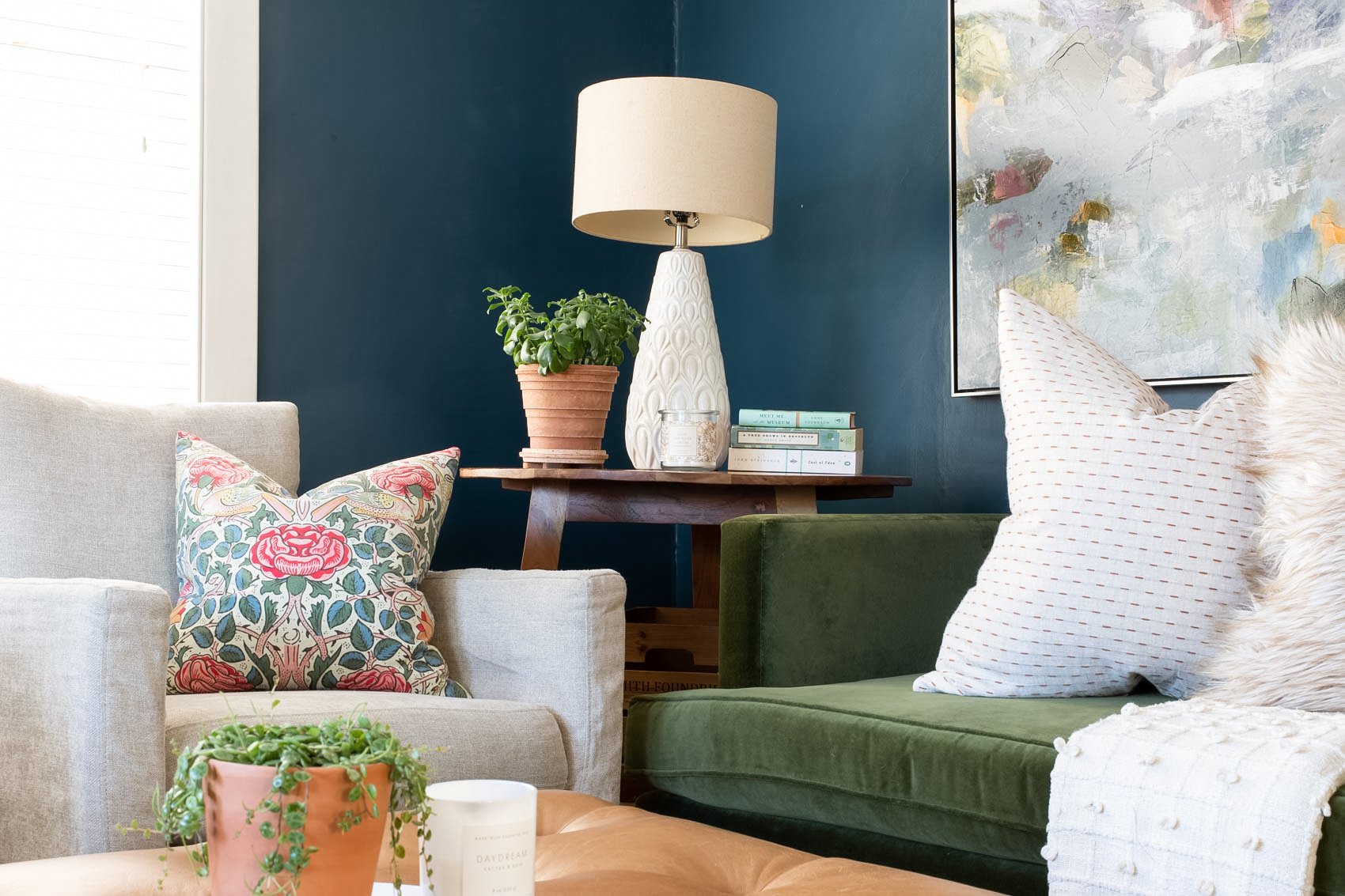Seven Tips to Level-up Your Living Room Design
Have you found yourself looking around your living room and wondering what you could do to make it more swoon-worthy, more in line with your tastes and personality? Here’s a few of my top design tips that are easy to incorporate in you own home, in a way that reflects you!
1. Contrast is Your Friend
A room without contrast is a lot like a song written with only one note. Boring! Dull! NOT AT ALL INTERESTING! And while we all have different key words about how we want our homes to feel— calm, inviting, colorful, luxurious, welcoming, etc—none of us are striving for dull and boring.
Contrast shows up in various forms—first and foremost is in color.
Color
Even in well designed, tone-on-tone rooms there’s contrast in color. Maybe it shows up in the metal finishes in the lighting or furniture legs. Maybe it shows up in the verdant hue of houseplants. I’m not saying you have to paint your walls a bold color like the Benjamin Moore, Newburg Green in my living room. I’m suggesting you not be afraid to bring in pieces that have color whether that be in art, accessories, or furniture items that vary in color.
It’s easy to fall into the mental trap that color is exclusively held by furnishings, soft goods, and wall paint. But color shows up in ALL the items that make up a room. The wood tones of your case-goods, the metal finishes of your floor lamp, the warm hues in your wood floors—all these also contribute to the overall color scheme in the room.
TIP—A fun exercise is to study a photo of a favorite design and count all the different tones in the room.
I’m a big believer in repeating color in a room, but vary up it up to have at least 2 different hues!
Texture
Another major player in adding contrast to a space is texture. It’s found in so many ways. Let’s start at the floor—area rugs bring in a layer of texture that’s easy to build on (more on ways to elevate your rug texture below).
Texture shows up in your window coverings whether they’re linen curtains or woven bamboo shades. It’s a big part of the upholstery of your seating choices, supple leather, luxurious velvet, warm wool, woven tweed…
Visual texture shines in art prints and canvases. Lamps and lamp shades offer another layer of discernible depth. Soft goods like pillows and throws are ripe with yummy textures that aren’t just visual but also tactile.
AND Baskets, oh my I love a good basket or three! Baskets offer instant visual texture and bring in that old-world craftsmanship feeling. And they’re so functional!
Another way to make contrast work for your room is to avoid matchy-matchy furnishings, instead try combining leather and fabrics.. A room will have a lot more visual interest if you incorporate seating options that aren’t all the same style, color, and upholstery. And don’t buy the lie that all your wooden furnishing have to match. They don’t! Aim for wood tones that are similar in warm or cool tones, but not exactly the same hue.
Sidenote—when I say don’t do matchy-matchy I’m not saying don’t have things that DO match, cause repetition in a room matters. Instead I’m saying make sure everything isn’t playing the same note! For instance, in my living room I have two green velvet sofas and two natural linen swivel chairs. This helps to create cohesion. But those items are juxtaposed against the blue walls, white trim, and the cognac leather ottoman. Lots of contrast AND repetition!
2. Remove the Glass from Your Art Frames
This design tip doesn’t involve anything but a little bit of time! If your art isn’t precious consider removing the glass from the frames. In a room with lots of natural light—like my living room—there can be a lot of glare caused by the reflection happening on the glass. An easy fix to that issue is just to remove it. It’ll also allow the print texture and art pigmentation to shine instead of the glass glare.
I probably wouldn’t do this in a bathroom where there’s a lot of humidity, or in a hallway where there’s potential for traffic to brush up against it. In areas where the art is not as likely to be “in the way” I’ve removed the glass from my framed art. I really appreciate how it gives my art prints an elevated look. Try it and see what you think!
My 3rd design tip is one that involves using furniture in unexpected ways—
3. Use Small Dining Tables as End Tables
As you can see from the pic above and below I’ve used small round dining tables as end tables in my living room. Here’s why this style tip works—a 30″ dining table/ bistro table is the perfect size to fit in the space when you place furniture perpendicular to each other.
For instance in my living room the two green sofas are parallel to each other and two swivel chairs perpendicular to the sofas. A smaller table would get lost in those corners. Not only is the 30″ round table a perfect fit in the space, the height of the table at 30″ is also so user-friendly to land that cup of morning coffee or afternoon tea.
The scale of the larger end table gives the corner that extra oomph it needs not to get lost in the design of the room.
I love how the table peeks through in this photo. Also, let’s chat a little more about contrast. Check out all the ways that particular style trick shows up in this vignette. The contrast of the green velvet sofa juxtaposed with the linen chair and the leather ottoman all against the dark navy walls. And notice the white trim, lamp, and pillows alongside the warm wood of the table and the terracotta planters.
Another easy way to level up your living room design is to curate the look with both old and new furnishings—
4. Mix Old and New
I can’t talk about tips for designing a living room you love without talking about mixing in both old and new pieces. That combination of old and new gives a room a curated vibe. One that creates interest. Plus, adding in older furnishings alongside new pieces helps a room have a lived in look. Older pieces are typically full of lovely timeworn patina that you just don’t get with new furnishings.
I love how the old trunk I found at a local antique store fits perfectly in this corner under our mounted TV. It gives off a travel aura and tells a story of adventure! And it looks fabulous beside my new green velvet sofa.
Mixing old and new furnishings also helps to avoid the look that says you shopped at the same furniture store for all your stuff.
I love how the patina of the old trunk and the terracotta planter combines with the warm brass and marble of the new martini table. So much contrast and visual interest!
5. Bring in Plants
Can this one even be considered a design tip or is it more of just my passion to share with the world?! Only you can decide.
If you been a reader of my blog for very long you know I’m a lover of plants. It’s hard for me to write a post without mentioning them. Not only are they good for the air in your home, the organic nature and green color they offer have a way of bringing a room to life.
If your thumb isn’t green—or if you have a room that doesn’t get enough natural light—a lot of faux options out there these days look authentic. (Check out this post for help making a faux tree look real) Also, your local nursery can be a great resource for helping you pick plants that are both easy to grow and will appreciate the particular natural light that your space gets.
Truly though, a strategically placed plant has the potential to take a room from boring to exciting. Got a room that needs a little something-something? Add in a plant and see how it immediately brightens the space!
6. Use a Rug Pad
This style tip is easy to overlook. But do yourself a favor and layer a lux rug pad under all your rugs. A thick pad elevates the look and feel of an area rug. It’s a subtle thing, but it makes a HUGE DIFFERENCE. Plus, a rug pad will help to keep your rug from slipping. This one is a great option. For rugs that withstand a lot of traffic consider adding these corner grippers to keep the rug from that dreaded corner curl-up.
If you’re not already doing this you gotta try it. It’s a fairly inexpensive way of making your rug feel a lot more luxurious to your feet and to the whole visual feeling of the room. A simple rug pad can make an inexpensive rug appear to more high-end.
And last but not definitely not-the-least-important design tip—
7. Incorporate Multiple Sources of Lighting
Y’all, lighting IS SO IMPORTANT! A beautiful space can turn harsh when you only have overhead lighting. On the other hand, when light is coming from multiple sources it has an instant cozy feel.
I often ask myself when I’m designing a room for myself or my E-design clients whether one can have too many lamps? They’re the easiest way to add in a layer of lighting. Table lamps and floor lamps source light at different heights in the room. Plug-in wall sconces are another great way to add a light source without having to do electrical work. And that’s what we’re aiming for—lighting coming from various elevations and sources throughout the space.
Adding dimmers to your light sources are way to level up the cozy-meter! Dimmers give you control over the mood in the room. And who doesn’t want cozy AND control!








